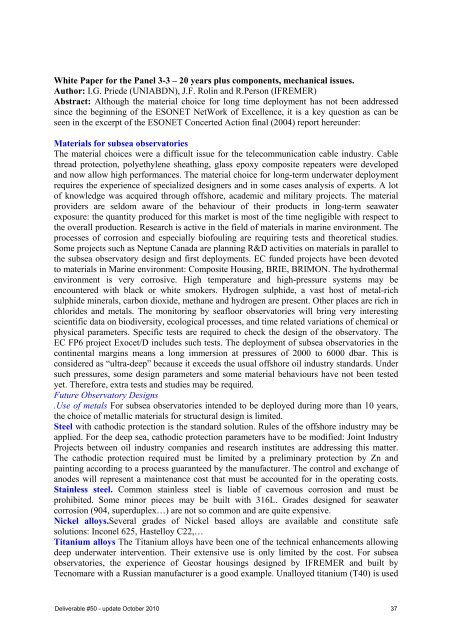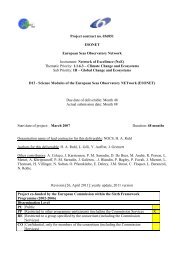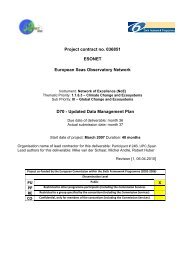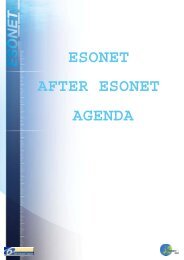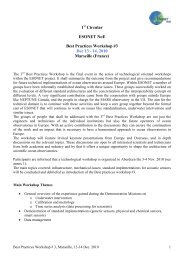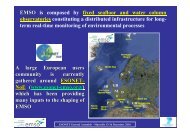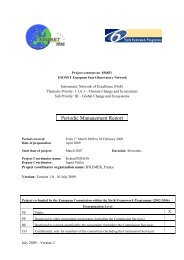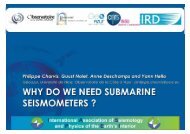Project Deliverable D50 Report on Best Practices ... - ESONET NoE
Project Deliverable D50 Report on Best Practices ... - ESONET NoE
Project Deliverable D50 Report on Best Practices ... - ESONET NoE
You also want an ePaper? Increase the reach of your titles
YUMPU automatically turns print PDFs into web optimized ePapers that Google loves.
White Paper for the Panel 3-3 – 20 years plus comp<strong>on</strong>ents, mechanical issues.<br />
Author: I.G. Priede (UNIABDN), J.F. Rolin and R.Pers<strong>on</strong> (IFREMER)<br />
Abstract: Although the material choice for l<strong>on</strong>g time deployment has not been addressed<br />
since the beginning of the <strong>ESONET</strong> NetWork of Excellence, it is a key questi<strong>on</strong> as can be<br />
seen in the excerpt of the <strong>ESONET</strong> C<strong>on</strong>certed Acti<strong>on</strong> final (2004) report hereunder:<br />
Materials for subsea observatories<br />
The material choices were a difficult issue for the telecommunicati<strong>on</strong> cable industry. Cable<br />
thread protecti<strong>on</strong>, polyethylene sheathing, glass epoxy composite repeaters were developed<br />
and now allow high performances. The material choice for l<strong>on</strong>g-term underwater deployment<br />
requires the experience of specialized designers and in some cases analysis of experts. A lot<br />
of knowledge was acquired through offshore, academic and military projects. The material<br />
providers are seldom aware of the behaviour of their products in l<strong>on</strong>g-term seawater<br />
exposure: the quantity produced for this market is most of the time negligible with respect to<br />
the overall producti<strong>on</strong>. Research is active in the field of materials in marine envir<strong>on</strong>ment. The<br />
processes of corrosi<strong>on</strong> and especially biofouling are requiring tests and theoretical studies.<br />
Some projects such as Neptune Canada are planning R&D activities <strong>on</strong> materials in parallel to<br />
the subsea observatory design and first deployments. EC funded projects have been devoted<br />
to materials in Marine envir<strong>on</strong>ment: Composite Housing, BRIE, BRIMON. The hydrothermal<br />
envir<strong>on</strong>ment is very corrosive. High temperature and high-pressure systems may be<br />
encountered with black or white smokers. Hydrogen sulphide, a vast host of metal-rich<br />
sulphide minerals, carb<strong>on</strong> dioxide, methane and hydrogen are present. Other places are rich in<br />
chlorides and metals. The m<strong>on</strong>itoring by seafloor observatories will bring very interesting<br />
scientific data <strong>on</strong> biodiversity, ecological processes, and time related variati<strong>on</strong>s of chemical or<br />
physical parameters. Specific tests are required to check the design of the observatory. The<br />
EC FP6 project Exocet/D includes such tests. The deployment of subsea observatories in the<br />
c<strong>on</strong>tinental margins means a l<strong>on</strong>g immersi<strong>on</strong> at pressures of 2000 to 6000 dbar. This is<br />
c<strong>on</strong>sidered as “ultra-deep” because it exceeds the usual offshore oil industry standards. Under<br />
such pressures, some design parameters and some material behaviours have not been tested<br />
yet. Therefore, extra tests and studies may be required.<br />
Future Observatory Designs<br />
.Use of metals For subsea observatories intended to be deployed during more than 10 years,<br />
the choice of metallic materials for structural design is limited.<br />
Steel with cathodic protecti<strong>on</strong> is the standard soluti<strong>on</strong>. Rules of the offshore industry may be<br />
applied. For the deep sea, cathodic protecti<strong>on</strong> parameters have to be modified: Joint Industry<br />
<str<strong>on</strong>g>Project</str<strong>on</strong>g>s between oil industry companies and research institutes are addressing this matter.<br />
The cathodic protecti<strong>on</strong> required must be limited by a preliminary protecti<strong>on</strong> by Zn and<br />
painting according to a process guaranteed by the manufacturer. The c<strong>on</strong>trol and exchange of<br />
anodes will represent a maintenance cost that must be accounted for in the operating costs.<br />
Stainless steel. Comm<strong>on</strong> stainless steel is liable of cavernous corrosi<strong>on</strong> and must be<br />
prohibited. Some minor pieces may be built with 316L. Grades designed for seawater<br />
corrosi<strong>on</strong> (904, superduplex…) are not so comm<strong>on</strong> and are quite expensive.<br />
Nickel alloys.Several grades of Nickel based alloys are available and c<strong>on</strong>stitute safe<br />
soluti<strong>on</strong>s: Inc<strong>on</strong>el 625, Hastelloy C22,…<br />
Titanium alloys The Titanium alloys have been <strong>on</strong>e of the technical enhancements allowing<br />
deep underwater interventi<strong>on</strong>. Their extensive use is <strong>on</strong>ly limited by the cost. For subsea<br />
observatories, the experience of Geostar housings designed by IFREMER and built by<br />
Tecnomare with a Russian manufacturer is a good example. Unalloyed titanium (T40) is used<br />
<str<strong>on</strong>g>Deliverable</str<strong>on</strong>g> #50 - update October 2010 37


